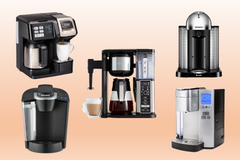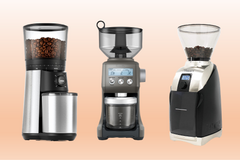
In fairy tales and mythology, we often read about life-giving elixirs. For us coffee aficionados, this magic elixir is a hot cup of joe brewed from some freshly ground beans.
Emphasis on freshly ground.
Freshly ground coffee has a few delicious benefits over other coffees.
First, there’s the flavor — pre-ground coffee is more susceptible to damage from the elements. Oxygen, moisture, direct sunlight, and heat all degrade ground coffee, thus altering its flavor.
This is one of the major reasons why freshly ground coffee tastes so much better. It hasn’t been exposed to the ravages of the elements.
Then, there’s the aroma.
Grinding coffee beans just before brewing protects this, as well as their natural flavor. It also prevents them from going stale or bland.
When ground, the coffee beans release hundreds of volatile aromatic compounds. These last briefly before they are lost to the air, and this is why most coffee lovers always have a coffee grinder within easy reach.
However, there are certain circumstances where a grinder might not be available. If you find yourself in such a dire situation, do not panic.
Here are some tips to help you grind coffee beans without a grinder.
Tools to Grind Coffee Beans Without a Grinder

Coffee Origin 3-Bag Variety Box
When working with minimal resources, you need to get creative. Look around your kitchen, hotel room, or campsite to see if you can find any of these tools:
- Blender
- Pestle and mortar
- Hammer (or mallet/meat tenderizer)
- Rolling pin
- Hand mincer or garlic press
- Knife and chopping board
The goal with these tools is turning your beans into coffee grounds that you can use to brew a pleasant cup of coffee.
Otherwise, you might as well run to the corner store and get a cup of stale, burnt coffee.
Also, make sure to grind your beans sufficiently, but without pulverizing them.
Method #1: Use a Blender
If need be, you can use a blender as your coffee grinder substitute. The blender blades work much like a blade grinder — they spin up, grinding the beans into coarse to medium-coarse grounds.
Some blenders even include a grinder setting specifically designed for use on coffee. Check for this before grinding coffee beans using your blender.
If it has the settings, and even if it doesn't, here's how to grind coffee beans in your blender:
- If your blender has a “grinder” or “medium-high” setting, select it.
- Add a small amount of your beans into the blender. About ¼ cup to ½ cup is ideal.
- Grind the beans using the pulse setting in bursts of 3 to 5 seconds. Any longer and you risk overheating the beans, resulting in harsh, bitter-tasting coffee.
- Repeat for a maximum of 6 bursts or a total of 30 seconds.
- If need be, tilt the blender to the side to encourage a more consistent grind. This also stops your blender from getting gunked up and stuck, and your motor from burning out.
Pro Tip: Keep the lid on your blender while coffee grinding — well, unless you want to have coffee bean shrapnel flying all over your kitchen.
Method #2: Pestle and Mortar Grinding

All across Ethiopia, the birthplace of coffee, a coffee ceremony known as “bunna maflat” (which translates to ‘to brew coffee’ in Amharic) is performed.
The ceremony involves washing green coffee beans and roasting them in a pan over an open flame. The roasted beans are then brought into the room, where guests are seated for them to savor the aroma.
The beans are then ground using a wooden mortar and pestle, and brewed in a pot called the “jebena” (which happens to be the inspiration behind our logo).
All of this is to say that the pestle and mortar are perhaps the most authentic way to grind coffee beans. It might take a little longer than using a blender, but it gives you far more control.
A pestle and mortar will give you anywhere from coarse to fine grinds. And, after what we’ve learned about bunna maflat, this option has a certain romance to it.
Here’s how to grind coffee beans using a pestle and mortar:
- Fill your mortar about ¼ full with beans — for better control and to prevent any spills.
- Hold the pestle in your dominant hand, and with your other hand hold the mortar.
- Press down on the beans using the pestle and crush them in a twisting motion.
- Roll them around in the mortar and repeat until you achieve your desired consistency.
- Empty your ground coffee into a bowl and repeat until you have enough.
Related: The Quick Guide to Brewing an Amazing Cup of Coffee
Method #3: Break Out Your Hammer
In a pinch, your hammer is yet another handy tool you can use in place of your coffee grinder. But, before you start pounding your beans, there are a few things you need to keep in mind.
Here’s how to grind coffee beans using a hammer as a coffee grinder:
- Place your desired amount of beans in a Ziploc or freezer bag. Squeeze the air out before sealing. Then, place the bag on a large enough cutting board.
- Hold the hammer in your dominant hand and press it down into the beans. DO NOT strike your beans like you would a nail. You can wrap the bag in a towel to protect it from tearing.
- Work from one end of the bag to the other and move the crushed beans around. This will help ensure an even coarse to medium-coarse grind.
Pro Tip: You can also use a meat tenderizer or a small mallet instead of a hammer. And, if you are out camping and have no access to either of these, you can also use a cast-iron skillet.
Method #4: Roll Your Beans
The humble rolling pin is a surprisingly handy coffee grinder substitute when in a bind. Thanks to its design, it can produce a relatively uniform grind.
However, using a rolling pin when grinding coffee beans requires some elbow grease. It also demands that you pay close attention to the grinding process to ensure uniformity.
With a bit of precision, you can achieve a medium grind perfect for pour-over brews.
Here’s how to grind coffee beans using a rolling pin:
- Place your desired amount of coffee beans into a Ziploc or freezer bag. Squeeze the air out before sealing to avoid popping it later on.
- Place the bag on your cutting board or kitchen counter.
- To get things started, use the rolling pin in the hammer-method to crush the coffee beans. You can wrap the bag in a towel to protect it.
- Firmly roll the pin back and forth over the coffee bag.
- Gather the beans to the middle of the bag and repeat until you achieve your desired consistency.
Pro Tip: You can also use a sturdy glass or wine bottle instead of a rolling pin. The larger surface area helps speed things up a little, but be careful when using these — you don’t want any broken glass in your coffee or in your hands.
Method #5: Hand Mincer or Garlic Press Grinding

A hand mincer or garlic press typically contains an internal blade assembly to finely chop whatever you put in it. Even coffee beans.
However, like coffee grinders, mincers and garlic presses can produce extra coarse grinds.
Thankfully, you can run your coffee grounds through the mincer or press however many times it takes to achieve your desired consistency.
Note that with a hand mincer or garlic press, you can only grind a small number of beans at a time. But, the devices make up for this by achieving different grind consistencies depending on the number of times you run your coffee through.
Here’s how to get the best results when using either device:
- Place a small number of beans into the hand mincer or garlic press. Make sure to place a bowl underneath to catch your coffee grounds.
- Firmly squeeze the device or turn the crank until all your coffee beans pass through.
- Empty the bowl’s contents back into your mincer or press and repeat to achieve your desired grind.
Related: Looking to Perfect Your Brew? Basics for Crafting Great Coffee
Method #6: Use a Knife
If you cannot find any of the above options, a knife will also get the job done just as well. Just be sure to use one with a wide, stiff blade — the idea is to squash the beans like you would garlic.
While it's possible to chop your coffee beans, this isn’t ideal and could be dangerous. Not to mention it would take an eternity.
Crushing the coffee beans gives you more control and lets you achieve a medium to fine grind.
Here’s how you grind coffee beans using a knife:
- Place your coffee beans on a cutting board.
- Place the flat of the blade directly on top of your beans with the sharp edge on the board.
- Place your palm on the blade and firmly push down against the beans to crush them. Use gentle force at first, until you get into a groove.
- When the beans are broken, continue pushing down on the blade. For a finer grind, you can pull it slightly towards at the same time.
Pro Tip: Crushing coffee beans using a knife can cause residue to fly all over the place. Cover the blade with a kitchen towel to prevent this mess, and avoid striking the blade like you would when crushing garlic.
Method #7: Free Starbucks Grinding
The above options are some of the quickest and easiest ways to grind your coffee beans at home without a grinder. But, admittedly, some of the options can be crude, time-consuming, and exerting.
Thankfully, there is another way to a perfect grind: your local Starbucks.
#ProTip: Your local Starbucks can grind coffee for almost any brewer and filter. And it's free! pic.twitter.com/1Mymt7EdPE
— Starbucks Coffee (@Starbucks) April 22, 2015
Of course, there are a few caveats you’ll need to keep in mind.
For instance, Starbucks will only grind your coffee beans for you if:
- They are Starbucks branded
- The bag is unopened
- The beans are not expired
These measures ensure food safety standards and prevent flavor cross-contamination.
Additionally, when you bring your coffee beans to Starbucks for them to grind for you, consider the time of day you go in. Aim for off-peak hours to save yourself a bit of time.
And, to save even more time, know the grind you want before going in. This will also help you make better coffee, depending on the brew method you use.
In fact, the type of grind should be your primary consideration before settling on an alternate method to grind coffee beans.
Here’s a quick breakdown to help you along.
Grind Consistency: How to Enjoy Your Freshly Ground Coffee

Grind consistency is essential in a perfect cup of coffee. It enables you to extract the flavors in your coffee beans with accuracy.
An inconsistent grind size might lead to over or under extraction, which negatively impacts the flavor of your coffee.
Additionally, grind size consistency will also dictate how to enjoy your cuppa joe best.
For instance, a French Press requires a coarse coffee grind, Moka pots and espresso machines need a fine grind, and drip coffee is best brewed with a medium grind.
Related: On the Coffee Grind — Different Grinds for Different Brews
| Grind | Coarse | Medium | Fine | Extra Fine |
| Description | Slightly smaller than extra coarse grounds, but still impressively sized with clearly defined particles. | Very gritty. Similar in texture to coarse sand. (Though not beach sand, which is significantly finer.) | Similar in feel to fine sugar, where you would be able to feel each grain. | Similar in consistency and feel to powdered sugar. You should not be able to feel individual grains. |
| Best Use |
Old-School Percolators |
Pour-Over Coffee Makers |
Moka pots Espresso Machines |
Turkish Coffee |
Expand Your Coffee Horizons
Above are a few creative techniques to grind coffee beans without a grinder. And, with the right beans, that cup of coffee will be well worth it.
But what exactly are “the right beans”?
In a nutshell, they are the highest quality, ethically sourced coffee beans you can get your hands on — kinda like those we offer at Nomad Coffee Club.
Nomad Coffee Club is a coffee subscription service for coffee lovers by coffee lovers.
We pride ourselves on providing our customers with the best quality, 100% organic coffee sourced from across the globe.
"Nomad is one of a kind and truly lives up to the name providing artisanal coffees from all over the world."
— Joseph Burkholder
Joining the club gives you instant access to our monthly selection of fresh, roasted to order, ready to brew beans.
Additionally, we have plans to best suit your every need, whether you want fresh selections for your home, office, or even a gift for your friend or loved one.
So, what are you waiting for? Join the tribe.







I want to try the Ethiopian method, brewing in a Jebena, preferably around a campfire… That’s the plan! Might aquire a larger mortar and pestle for this adventure 👍